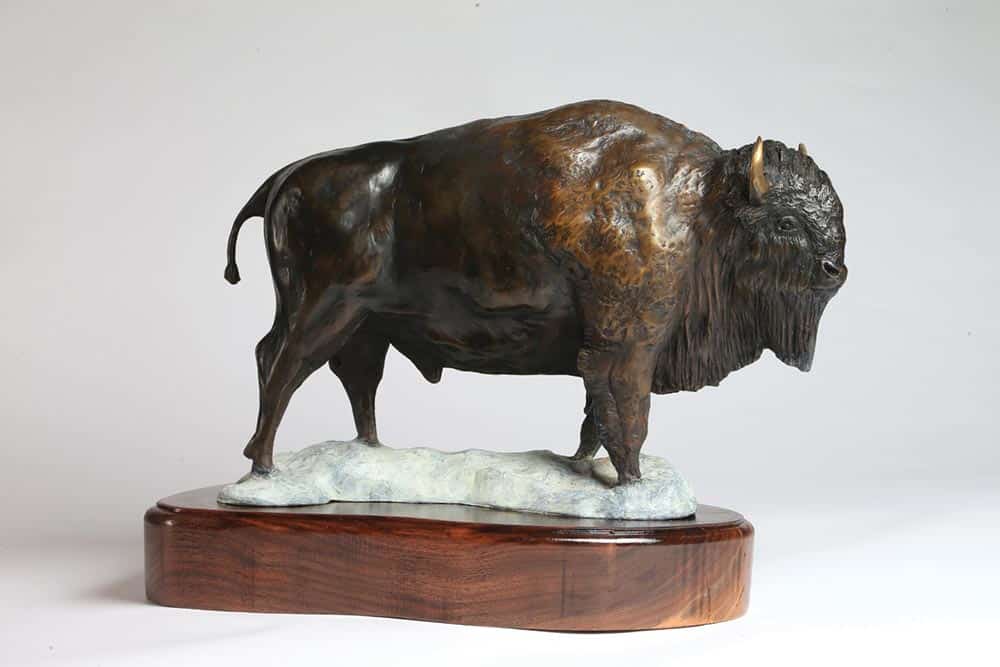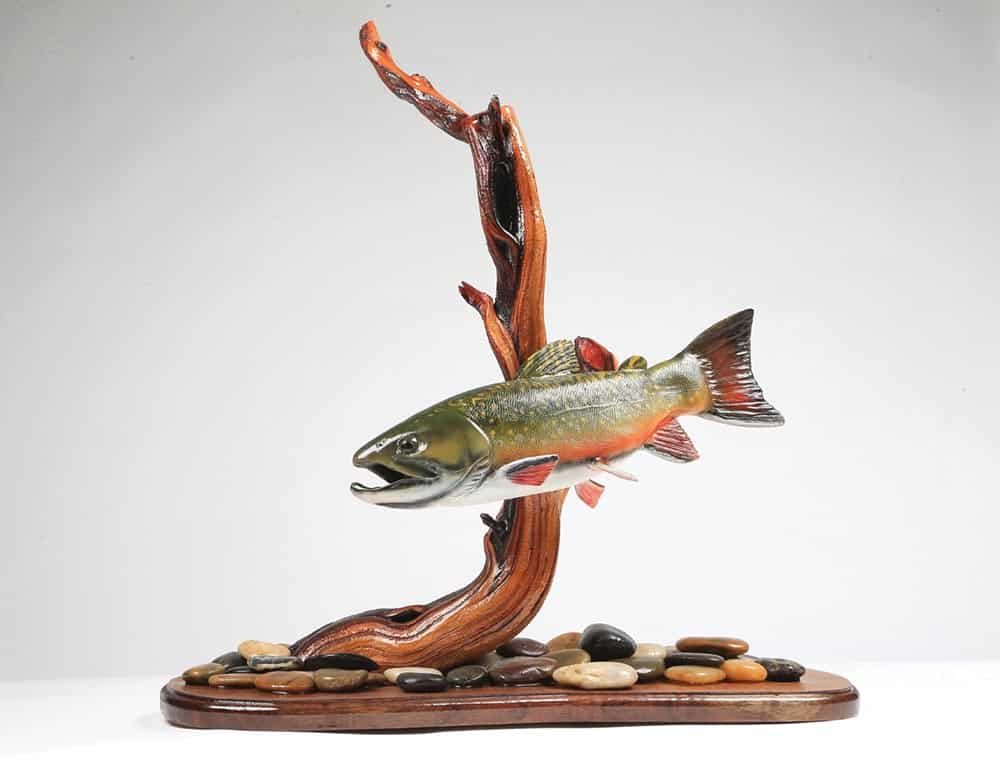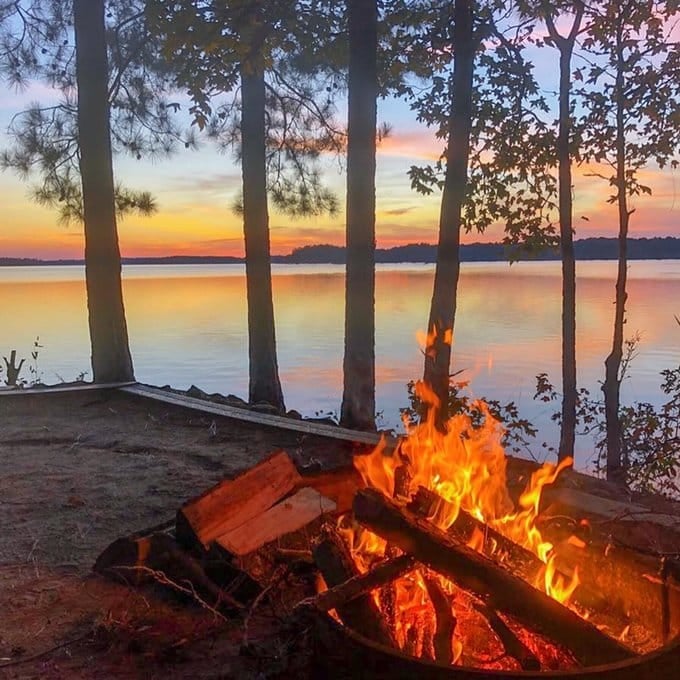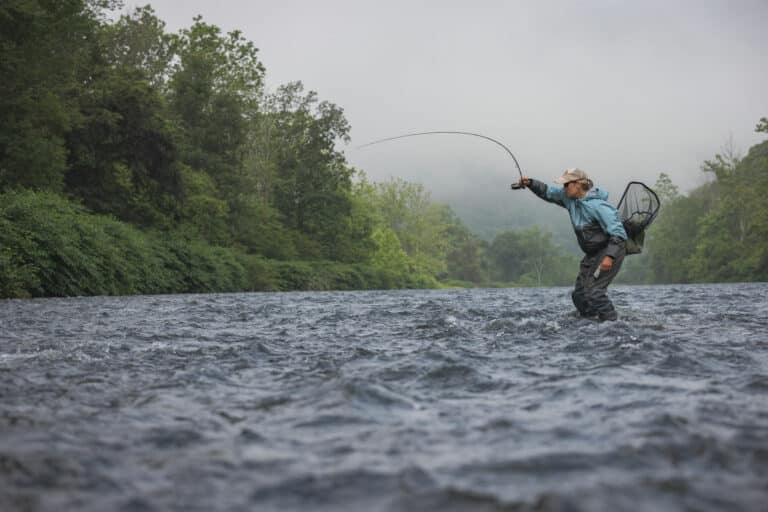Although he got his start fishing in Arizona as a kid, Ryan Smith says the brook trout native to the waters of the Mid-Atlantic inspire most of his sculptural work. Using bronze and wood, he crafts lifelike displays of wildlife with attention to detail and inventive manipulation of material.
Smith drew for a number of years before deciding to try his hand at a 3D medium. “My aim, although I am sure I fall short at times, is to create sculptures of wildlife that emulate the beauty of trout and other species,” he said. “I would also like to think that when a fly fisherman is looking at one of my pieces, he or she is remembering a fish caught or inspiring another trip to their favorite river or stream.”
As an artist and an angler, Smith gets most of his inspiration for pieces while out on the waters of the region. Some of his favorites include the Chesapeake Bay, Deep Creek Lake, and Rappahannock River. “I’ve noticed that when I want to fly fish, a good outlet for that is the sculptures,” he said. “In a way, it’s a substitute for not being able to get out as much as I would like to go fishing.”
The Technique
When starting a new piece, Smith works from his own memory of handling fish, as well as photos for reference, so that he can capture the nuances of form and color. For his early pieces, he carved the fish out of wood, shaping a four by four by 10 block of wood with a variety of tools to get it into the correct shape.
To refine the details, he utilizes a variety of saws, sands using a Dremel tool to add some definition, and then burns thousands of scales into the side. “Once I have the form and shape down correctly, I spend almost an equal amount of time painting the carving,” Smith said. The wood as a material lends itself to intricate paintings that capture the wide array of hues found on trout and other species of fish. All told, Smith said he spends anywhere from 40 to 80 hours on a single piece, working the wood down a layer at a time until the proportions match up.
As he spent more time learning the craft, Smith started looking for new ways to sculpt his pieces. He eventually started making the transition to bronze as his primary medium, as he felt like the wood carvings could look too much like replicas. “I wanted to have a little bit more artistic freedom,” he said.
Smith will first sculpt a bronze piece using an oil-based, sulfur-free clay. When all of the details are up to his standards, he works with a foundry to cast it in bronze through a process known as the lost-wax method. Using the clay model, the foundry will make a mold into which hot wax is poured. “Once that mold is finished, you essentially have a replica of the clay sculpture, but it’s with wax,” Smith explained. “The foundry makes another mold out of the wax positive mold and then pours molten bronze in that second mold, leaving the bronze sculpture. Then I work with the foundry on applying the patina by using a combination of heat and chemicals to give the sculpture some color.”
Although he will typically spend about 20 hours on the clay model, the entire process takes between two to three months before there is a final sculpture. While his piece is at the foundry, Smith will use that downtime to get started on another sculpture so that he always has something in the queue.

Always Looking for a New Direction
Over the years, Smith’s work has evolved as he tried new mediums and experimented with design. “When I first started out, I was so focused on just getting the piece right that I wouldn’t worry about the stand or presentation as much as I should,” he said.
In speaking with some of his mentors over the years, Smith began to understand the importance of the overall look, rather than just one part. “You need to focus on the whole thing to give it some context,” he said. “I think some of my earlier pieces were a lot stiffer and didn’t look like they had any movement in them. That really throws off the piece and makes people not as interested in it.”
Whether it’s incorporating some curvature into the fish’s body or designing an appropriate pedestal, Smith is working to build out the final appearance so that when it sits on display, the viewer feels compelled to look closer. “You want whoever’s looking at it to be thinking, ‘I’ve seen that fish when I was out fly fishing.’ That’s kind of my goal,” he said.
As he continues to push the limits of sculptural interpretation, Smith is looking to move away from true representations to include more abstract elements in his work. One of his most recent sculptures of a brown trout features the silhouette of mountains inspired by a fishing trip to Montana. And although he has sculpted a few other animals, including a peregrine falcon and bison, Smith plans to stick with the fish as his main inspiration. After all, working with what you know can lead to some pretty spectacular results.
You can find more of Smith’s work online at RyanSmithSculptures.com or Instagram @reel_carvings.
Cover photo: One of Smith’s bronze brook trout sculptures. Photo by Steve Whysall








